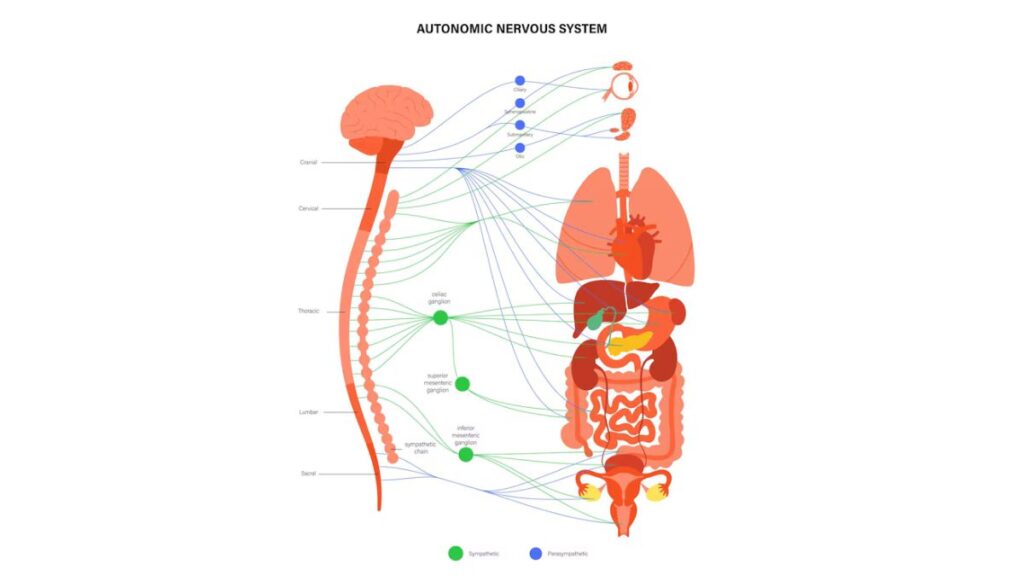The autonomic nervous system (ANS) plays a critical role in maintaining homeostasis, regulating involuntary physiological functions such as heart rate, respiration, digestion, and blood pressure. It is divided into the sympathetic and parasympathetic branches, which work in tandem to maintain balance. Increasing evidence suggests that spinal manipulation, a cornerstone of chiropractic care, can influence ANS regulation, offering a non-invasive approach to addressing dysautonomia and related disorders. This article reviews current findings on the connection between spinal manipulation and ANS regulation, highlighting both mechanisms and clinical implications.
The Relationship Between the Spine and the ANS
The spine serves not only as a structural support for the body but also as a protector of the spinal cord, which is integral to the transmission of neural signals between the brain and peripheral systems. Spinal segments house sympathetic ganglia and are closely associated with parasympathetic outflows, creating a direct link between spinal health and ANS function.
Misalignments or dysfunctions in the spine, known as vertebral subluxations, may compromise this neural communication. Such interference can result in imbalances within the ANS, contributing to various conditions such as chronic pain, stress disorders, and hypertension. Spinal manipulation, which aims to restore proper alignment and mobility, has been hypothesized to influence ANS activity and promote physiological equilibrium.
Mechanisms of ANS Modulation Through Spinal Manipulation
While the exact mechanisms by which spinal manipulation affects the ANS are still under investigation, several theories have emerged. One proposed mechanism involves the stimulation of mechanoreceptors in the spine and surrounding tissues. These receptors send afferent signals to the central nervous system, potentially influencing autonomic output.
Studies suggest that spinal manipulation may activate descending inhibitory pathways, which modulate sympathetic activity and reduce stress responses. Additionally, adjustments may enhance proprioceptive feedback, optimizing the balance between sympathetic and parasympathetic inputs. By influencing these pathways, spinal manipulation could help recalibrate the ANS, promoting homeostasis.
Clinical Evidence of ANS Regulation
Numerous studies have explored the impact of spinal manipulation on specific ANS-related parameters. Heart rate variability (HRV), a widely recognized measure of autonomic function, has been used extensively to assess the effects of chiropractic care. HRV reflects the balance between sympathetic and parasympathetic activity, with higher variability indicating better autonomic regulation.
Research findings have shown that spinal manipulation can improve HRV in both healthy individuals and those with dysautonomia. For example, studies on patients with chronic pain have demonstrated reductions in sympathetic overactivity following chiropractic adjustments. Similarly, improvements in parasympathetic tone have been observed in individuals with stress-related disorders, suggesting potential benefits for mental health and emotional resilience.
Beyond HRV, spinal manipulation has been associated with changes in blood pressure, respiratory rates, and gastrointestinal function, all of which are regulated by the ANS. These findings support the hypothesis that spinal health influences autonomic control, making chiropractic care a valuable tool for managing ANS-related dysfunctions.
Applications in Clinical Practice
The ability of spinal manipulation to modulate ANS activity has significant implications for clinical practice. Patients with conditions such as hypertension, irritable bowel syndrome, and chronic stress may benefit from chiropractic interventions that address underlying autonomic imbalances. By restoring spinal alignment and optimizing neural communication, practitioners can offer a holistic approach to health and wellness.
Furthermore, the non-invasive nature of spinal manipulation makes it an attractive option for patients seeking alternatives to pharmacological treatments. Chiropractic care is particularly valuable for individuals who experience side effects from medications or prefer a natural approach to managing their conditions.
Challenges and Future Directions
While the evidence supporting ANS regulation through spinal manipulation is promising, challenges remain. Variability in study designs, sample sizes, and methodologies has limited the generalizability of findings. More rigorous, large-scale research is needed to elucidate the specific mechanisms and long-term effects of spinal manipulation on autonomic function.
Additionally, integrating chiropractic care into multidisciplinary healthcare settings requires greater collaboration between chiropractors and other healthcare providers like Active edge Functional Medicine. Increased awareness of the scientific basis for spinal manipulation will help bridge gaps in understanding and foster greater acceptance of chiropractic care.
Conclusion
The regulation of the autonomic nervous system through spinal manipulation represents an exciting frontier in chiropractic research and practice. By influencing the delicate balance between sympathetic and parasympathetic activity, spinal adjustments offer a powerful means of promoting homeostasis and addressing a wide range of health conditions.
As research continues to advance, the integration of chiropractic care into broader healthcare models holds promise for enhancing patient outcomes and improving quality of life. The connection between spinal health and autonomic function underscores the profound impact of chiropractic care—not just on the spine, but on the entire nervous system.
Should you wish to explore other topics, head to our main blog. We’ve got more!







